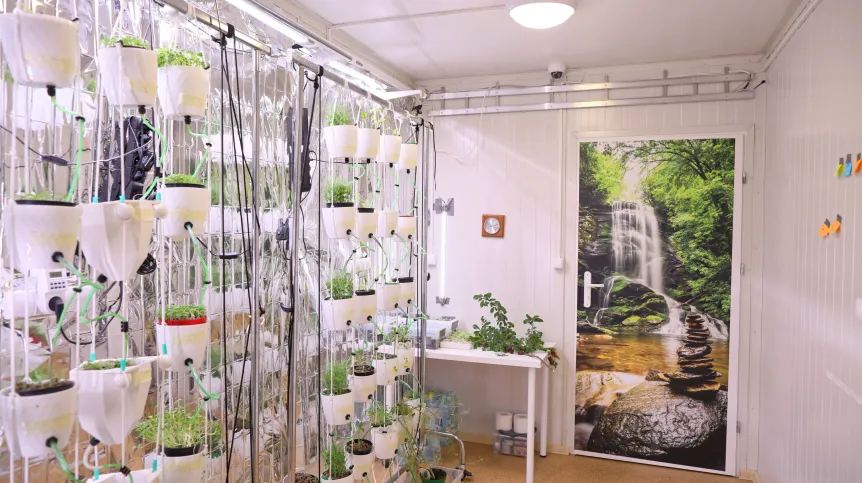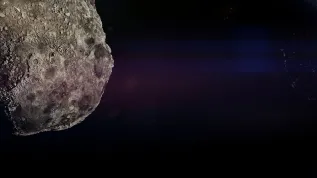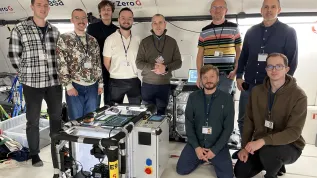
While the crew of the Ax-4 space mission stays on the International Space Station, 400 km below, analogue astronauts will take part in a mirror mission in the LunAres Habitat in Piła. This is part of a study of the impact of space isolation on human mental well-being.
The 'AstroMentalHealth' experiment will be conducted as part of the Polish technological and scientific mission IGNIS. Its results may contribute to the development of better psychological support systems for space crews.
'This is most likely the first such undertaking in the world, where the same research procedures will be implemented in parallel both in space and on Earth. The mirror mission will take place at the same time as the Ax-4 flight, but with a delay of several days, so that we know what is happening on the station and can reflect the given conditions', says the coordinator of the experiment, Agnieszka Skorupa, PhD, from the University of Silesia in Katowice.
The researchers will carry out the mirror mission in analogue conditions in the LunAres Habitat in Piła. This facility is located at the old military airport in Piła, in a converted military aircraft hangar. It was created with the idea of designing and testing space architecture needed for future missions to the Moon or Mars.
A total of 9 people will take part in the experiment. The first group, corresponding to the current crew of astronauts on the ISS (5 people), will be subjected to three-week isolation. After a few days the crew will be joined - for a period of two weeks - by 4 new people, analogues of the Ax-4 mission crew.
The habitat director Leszek Orzechowski emphasises that the composition of the group mirroring the Ax-4 crew should best reflect the age, gender, cultural and professional structure of real astronauts. 'There will be one woman (with experience in managing an analogue mission) and three men. Three people have already been selected, only three candidates for the 'mirror Sławosz' are still being interviewed', says Orzechowski, who coordinates this ground part of the experiment.
He adds that the researchers themselves recruited members of the analogue Ax-4 crew - according to previously provided criteria.
In turn, the recruitment for members of the analogue ISS was open. Candidates had to send their CVs, cover letters, and pass the interview stage. 'We selected 5 people from among 20 applicants. These are people dealing with space-related topics: employees of space agencies, companies that train astronauts, scientists who want to test themselves in conditions of isolation, working in a multicultural team and under time pressure. They come from all over the world - from Australia, the United States, Europe and North Africa', Leszek Orzechowski says.
There are no Poles in this group. Orzechowski assumes that the date is not convenient for our compatriots, because those who professionally deal with space missions will probably be involved in the mission with the participation of Sławosz Uznański-Wiśniewski, while academics and students have the end of the semester and the beginning of the exam session during that time.
'We still have one place for the analogue crew of the International Space Station; you can still apply', Orzechowski encourages.
The mirror mission is the most faithful reproduction of a space mission possible. 'We received a full astronaut schedule from the European Space Agency, according to which we developed a schedule of activities in the habitat. Our crew will also conduct experiments, although not exactly the same ones, because it is not possible for technical reasons, among other things. There are even plans for media interviews. We try to ensure that our crew is overwhelmed with work and that after a whole day they are as tired as the astronauts on the ISS', the habitat director says.
All this is to investigate how astronauts adapt to such unfavourable conditions of isolation as on the ISS; how they cope and what they experience during the mission - and to compare all this to the results from the real mission.
'The hangar surface is covered with 400 tons of sand and 400 tons of basalt, there is no access to sunlight, and the only exit simulates a lock through which you go on simulated space walks. Our architects converted sea containers into space station modules: a workshop, a biological laboratory, a capsule hotel, a kitchen, a bathroom. The entire space is about 150 square meters', Orzechowski describes the conditions in the habitat.
The entire space is constantly monitored by the habitat team - not only with cameras, but also, for example, carbon dioxide sensors.
'Participants in analogue missions are kept in isolation: they have no access to sunlight, their phones are locked in a safe, and they can only contact their families by email, although video calls are possible when simulating conditions on the ISS. However, apart from that, of course, there is normal pressure and gravity here, and in the event of an accident or health deterioration, we can pull the person out and take them to the hospital. Astronauts do not have this option', says the director, who has participated in two-week analogue missions three times.
The 'AstroMentalHealth' experiment - both in space and on the ground - involves collecting measurements from astronauts before, during and after the mission. Data will be collected in three ways. The first method is questionnaires (before, during and after the mission). The second involves interviews with astronauts before and after the mission, and analysis of video recordings that the astronauts will make during the mission. This will be complemented by analysis of the expression of emotions observed on the astronauts' faces during video diary recordings on the ISS.
Leszek Orzechowski emphasises that the greatest challenge is the uncertainty of the launch date. He explains that the experimenters, they cannot wait until the last moment, because part of the analogue ISS crew must start the experiment a week before the Ax-4 team joins. 'I admit that this keeps us awake at night, because the missions must take place at the same time so that we can compare the results. Although, of course, we are aware that unpredictability is an inherent part of space exploration', he emphasises.
'The plan is ambitious and interesting. This is the first time in the world that someone does such a mirror analogue mission. And it can always turn out that with this study we will disprove the point of analogue missions, that they may not reflect the real ones at all. This would be a great publication', he concludes with a smile.
The launch of the Ax-4 mission to the ISS with the Pole Sławosz Uznański-Wiśniewski is scheduled for June 8.
PAP - Science in Poland, Agnieszka Kliks-Pudlik (PAP)
akp/ agt/ amac/













